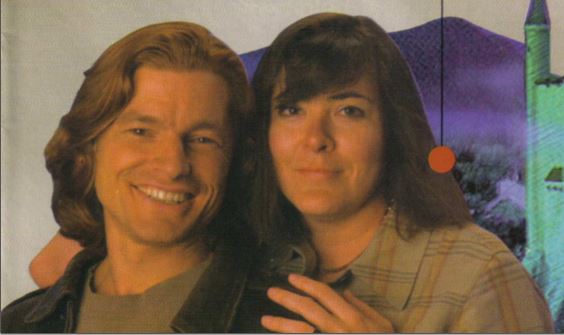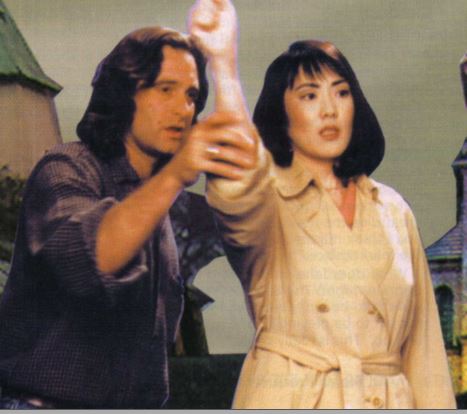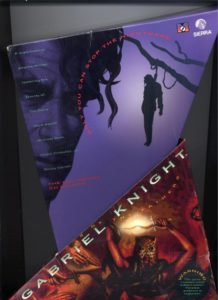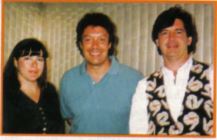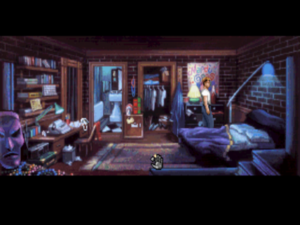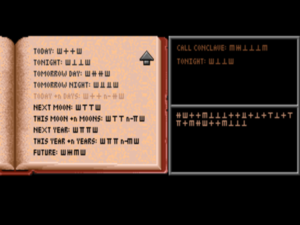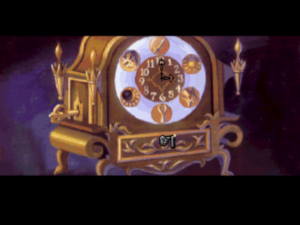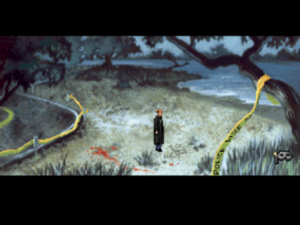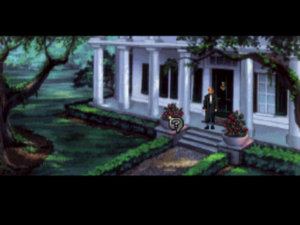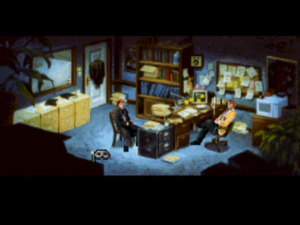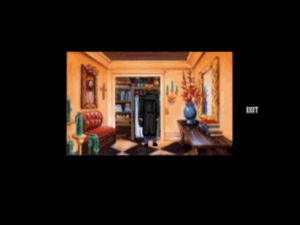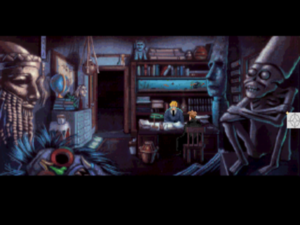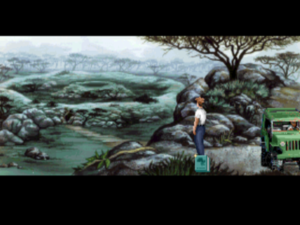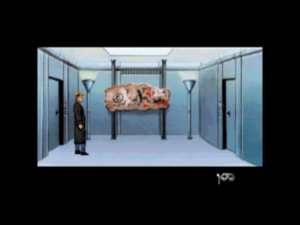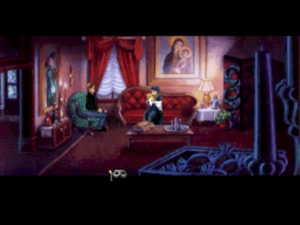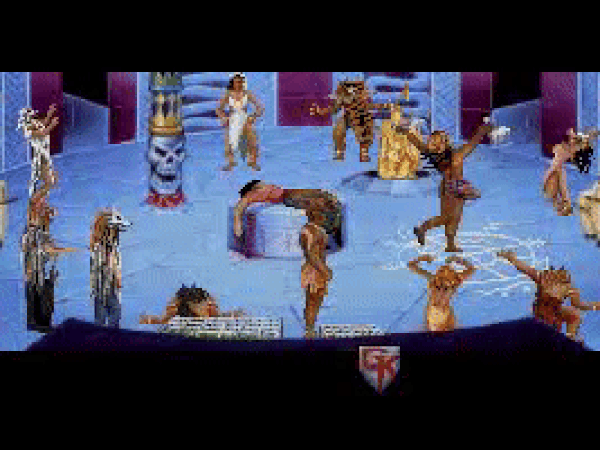Personally, I’ve never been one to imagine small things.
— Jane Jensen
When Jane Jensen first said that she would like to make a dark-tinged, adult-oriented mystery of a Sierra adventure game, revolving around an antihero of a paranormal detective named Gabriel Knight, her boss Ken Williams wasn’t overly excited about the idea. “Okay, I’ll let you do it,” he grumbled. “But I wish you’d come up with something happier!”
What a difference a year and a half can make. At the end of that period of time, Gabriel Knight: Sins of the Fathers was a hit, garnering vive la différence! reviews and solid sales from gamers who appreciated its more sophisticated approach to interactive storytelling. Rather than remaining an outlier in the company’s catalog, it bent Sierra’s whole trajectory in its direction, as Ken Williams retooled and refocused on games that could appeal to a different — and larger — demographic of players.
There was no question whatsoever about a sequel. In January of 1994, just six weeks after the first Gabriel Knight game had shipped, Jane Jensen was told to get busy writing the second one.
She was more than ready to do so. In fact, she already knew exactly what she wanted the second story to be: a tale of werewolves, Richard Wagner, and Ludwig II, the (in)famously eccentric last king of an independent Bavaria. She’d developed a fascination for all of these subjects when she’d spent nine months living in Germany just before coming to Sierra. “It was initially the plot for the first game,” she says, “but when I started looking at it, I felt I needed to go back further in the characters’ history.” Now, having told how a New Orleans pulp-novel writer, bookstore owner, lady’s man, and general layabout named Gabriel Knight became a “Schattenjäger” — a “shadow hunter” of things that go bump in the night — she was ready to send him to Germany to face The Beast Within.
Very early on during the design phase if not right away, The Beast Within was earmarked to become the second of a new generation of Sierra adventures, which were to be built around filmed snippets of live actors. It was an enormous change from the hand-painted pixel graphics of the first game, but Jensen was, as she says, “all for it.” Although shooting on location in Germany would have been her dream scenario, there was no way the budget would stretch that far. Instead her actors would have to perform in front of a blue screen that would be filled in with computer-generated backgrounds after the shoot, as was the norm for these kinds of productions.
In lieu of taking the whole project to Germany, she did convince management to allow her to bring a piece of that country to Sierra’s offices in Oakhurst, California. During the second half of 1994, she and other Sierra staffers made three separate trips to Germany, spending more than a month there in all, painstakingly photographing among other places Munich’s city center, the Wagner Museum in Bayreuth, and Neuschwanstein, “mad king” Ludwig’s fairy-tale castle. These photos were then touched up as necessary to serve as the scenery behind the actors. This in itself represented a marked change in approach from the 3D-modeled backgrounds employed by Phantasmagoria, Sierra’s first game of this type. It was a wise choice for this project; while the mixing of media is by no means always seamless, the photographic look gives The Beast Within an unusually strong atmosphere of place. The hazy, slightly washed-out look of the backgrounds — an unavoidable byproduct of the state of digital imaging at the time — contributes to rather than detracts from the mood. “We were lucky in all three of the trips over there in that it was fairly overcast, so we didn’t have any harsh, direct lighting on most of the things,” says Nathan Gams, the project’s creative director and chief photographer. “We wanted a soft, gloomy kind of European spring feel. It kind of reflects the alien place where Gabriel is at this time.”
With the background images duly captured, it was time to think about the foreground actors. The budget only allowed for the Screen Actors Guild minimum wage, which precluded “name” stars such as Tim Curry and Mark Hamill, both of whom had provided voice acting in the first game.
Sierra wound up casting in the role of Gabriel one Dean Erickson, a 36-year-old with an interesting story behind him. He had been working in finance on Wall Street at age 30, when he suddenly decided that he wanted to be an actor instead, despite having never performed in so much as a high-school play prior to that point. Six years on from that decision, his chief claim to fame was a bit part in three episodes of the sitcom Frasier. Jane Jensen was initially uncertain that he had the chops to play the role of Gabriel, even though in appearance he was “spookily like what I would have thought the character would be”: “It was more a matter of being sure that he could play all the different faces of Gabriel Knight.” But she allowed herself to be convinced in the end.
“I would like to be the lead guy in major features,” Erickson himself said at the time, “and hopefully my performance in this will lead someone to believe that I can help carry a movie.” Hope does tend to spring particularly eternal in Hollywood. In the world of reality rather than Hollywood fantasy, a much older and perhaps wiser Dean Erickson would come to look back on The Beast Within as the best that things ever got for him as an actor, what with “making SAG scale for three and a half months in an idyllic setting under controlled conditions with nice people.”
It was intense in that we shot fairly quickly, only one or two takes per shot. But we were mostly shooting on an air-conditioned sound stage in a beautiful part of the country during the summer near a lake. We worked mostly nine to five, Monday through Friday, so it was about the best situation one could have as an actor. It truly couldn’t have worked out better, other than maybe getting work afterwards.
The role of Grace Nakimura, Gabriel’s strait-laced research assistant and potential love interest, went to Joanne Takahashi, a stage actress and print-advertising model who was also trying to break through in Hollywood. Meanwhile a Polish actor named Peter Lucas would all but steal the show in the role of the darkly enigmatic Baron Friedrich Von Glower, who slowly emerges as the principal antagonist of the story. The cast was rounded out with more than 40 other speaking parts, all recruited like the leads from the ranks of Hollywood hopefuls flashing their SAG membership cards.
Sierra’s original choice as director was an in-demand music-video maker named Mark Miremont, whose grainy, hyperkinetic productions can be credited with inculcating much of the look of MTV during the grunge era. It would have been intriguing indeed to see what he might have done with The Beast Within. But those plans fell through at the last minute, and Sierra instead hired a less distinctive aesthetic personality named Will Binder, a graduate of UCLA film school who had recently been serving as a director’s assistant in such films as The Scent of a Woman.[1]This résumé would later lead to my favorite ever interview opening, from the adorably fannish website Adventure Classic Gaming: “You have worked with some of the best actors in the business — Al Pacino, Michael J. Fox, Bruce Boxleitner, Mira Furlan, Philip Seymour Hoffman, and of course, Dean Erickson and Joanne Takahashi.” Two of these names are not like the others…
Before talking about how any of these folks performed, it’s only fair that we take a moment to appreciate just how awkward this style of “film-making” really was. The difficulties and constraints extended even to the clothing worn by the cast; the chroma-keying process which allowed the programmers to superimpose the live actors over the digitized photographic backgrounds came complete with many restrictions, as noted by costumer Marcelle Gravel:
There are a lot of limitations in terms of colors. [We can’t use] anything that is close to blue or anything white that can reflect the blue, or any green that has a little blue in it. Sometimes black doesn’t work because when it gets wrinkled, it reflects.
So the wardrobe has to be very safe. Gabriel was supposed to be wearing a black jacket, a white tee-shirt, and blue jeans — an American uniform. It is James Dean, Marlon Brando, all those people. And when I started Gabriel, I can’t use black, I can’t use white, I can’t use blue. So what am I going to do to create that effect?
He ended up wearing green. Since he’s got the red hair, I think the green has a good effect on him.
The blue screen also meant that much or most of the evolved language of film had to be tossed. The camera wasn’t allowed to swoop or soar; it had to remain stock still if the computer-generated backgrounds were to look coherent after they were inserted. Thus the scenes had to be staged and blocked like live-theater productions which happened to perform for a camera rather than a live audience.
Making an interactive story, in which scenes could occur in many different orders, played havoc with the actors’ ability to inhabit their roles. Will Binder:
[The player] can jump around during the game at any point, so the actor has to have a neutral emotion at the start of each scene. [The scene currently being filmed] could [be] before a big scene happened or could [be] after a big scene.
In a regular movie, you would like to tell [the actor], “Okay, this just happened: you just broke up with your girlfriend.” Or, “An hour ago you found out some information about a person you have been dealing with.”
In the game, [the player] can go anywhere [they] want. So there is no linear progression.
Joanne Takahashi:
With this shoot, you are taking so many different paths you are not sure where the character is going. It is a challenge.
I am just feeling it through and letting things come to me as I go along. It was something to adjust to because a lot of what actresses do is inspired by what they are feeling. That was a difficult challenge, but that was a requirement on this kind of project.
Most of the actors were not technically oriented, and had little concept of how the scenes they were shooting would be cobbled together into a coherent final product. Certainly there was nothing like the daily rushes of conventional filmmaking, which help actors understand how a production is coming together while the shoot is still progress. The actors working on The Beast Within were swimming blind in unknown waters.
Keeping all that in mind, then, how did the actors do?
Dean Erickson is a rather counterintuitive case in some ways. On the one hand, he badly misses the mark of the Gabriel Knight that Jane Jensen likes to describe. Far from a cool lady-killer, he radiates discomfort in his own skin virtually every moment he spends onscreen; he’s forever sighing and twitching and glancing nervously away as if looking for direction (which he quite possibly is, come to think of it), coming across as a guy for whom propositioning a girl comes as naturally as foreign languages. (American to the core, Gabriel has managed to avoid picking up a word of German during the months he’s already spent in the country.) Needless to say, nothing about this performance will convince you that Erickson is Hollywood leading-man material.
And yet Erickson’s take on Gabriel kind of works despite itself. His discomfort before Will Binder’s cameras mirrors that which any born-and-bred New Orleanian would feel after being transplanted to such an utterly foreign clime as southern Germany. For all of Erickson’s manifest limitations as an actor, I have to say that I like his Gabriel more than I do the one Tim Curry voice-acted in Sins of the Fathers. He’s relatable in his way, and, if he doesn’t exactly radiate masculine virility, nor does he come across like a member of the #metoo Most Wanted brigade, as Curry’s Gabriel too often did. He’s not bad company on the whole, once you get used to his incessant fidgeting. In achieving this much, he fulfills the first and most important criterion of any good adventure-game protagonist.
But Joanne Takahashi’s Grace is, alas, less likeable. This is a problem in that Grace steps up to almost equal time with Gabriel in this second game; the player controls her rather than Gabriel through two and a half of the game’s six chapters. Her apparently unrequited affection for Gabriel and jealousy of his beautiful German secretary Gerde are doubtless intended to be endearing, but are written and acted with all the subtlety of a wrecking ball to the head. Whether because she’s got them old lovesick blues or because she’s just made that way, Grace is bitchy toward everyone and everything she encounters for much of the game. Only toward the end, when she’s finally accepted that Gerde isn’t after her man and that Gabriel really needs her help, does she start to lighten up a bit. But even then, the actress who plays her remains stiff as a board.
Peter Lucas by contrast gives by far the most natural performance, as Baron Von Glower, the libertine leader of a mysterious big-game hunting club which Gabriel stumbles upon in the course of his investigations. Every time he appears, he lights up the screen with his romance-novel looks and his enticing aura of danger; his scenes with Gabriel flare with far more sexual tension than Gabriel ever strikes up with Grace. Lucas’s onscreen performance stands out as one of the best of the entire full-motion-video era of gaming — granted, not an overly high bar to clear, but we should give him his props nevertheless.
The Beast Within took over Sierra’s new Oakhurst sound stage in May of 1995. Filming there lasted almost four months in all. At its conclusion, the crew moved to Seattle for a few days to shoot the game’s climactic scenes on location in the city’s opera house, complete with many of the local opera company’s own players. Here the constraints imposed by the game’s peculiar technological stew fell away, and Will Binder got to shoot something resembling scenes from a proper movie. He was a lucky guy; very few other full-motion-video productions from the 1990s ponied up for a full-fledged location shoot.
Coming to this article, I had fonder memories of The Beast Within than Sins of the Fathers, and I was curious to find out whether that impression would hold up. I was gratified that it generally did. The game is as shaggy as its namesake even if one looks beyond the uneven acting, being full of unnecessary stumbling blocks in its interactivity that prevent me from giving it a full-throated recommendation here or making a place for it in my personal Hall of Fame, where fairness to the player is a prerequisite. But it’s a fascinating piece of work all the same, created as it was just at the apogee of that window of time when interactive narratives starring “real” actors were considered the necessary future of gaming by big companies like Sierra — so much so that they were building million-dollar sound stages for themselves to churn them out with the alacrity of any Hollywood studio. Jane Jensen would never get a chance to work on a scale like this again. And it must be said that she made the most of it: the overweening ambition of The Beast Within — the sheer grandiosity of it all — makes it a sight to behold. This is a computer game for which an opera was composed, for God’s sake. Everyone involved with it was unabashedly shooting for the moon.
The game opens several months after the conclusion of Sins of the Fathers, when a very reluctant Gabriel has moved into his ancestral castle in Germany to take up the family business of shadow-hunting. Meanwhile Grace has been left behind in New Orleans to run his old bookstore.
One dark night, a group of German villagers straight out of Hammer Horror central casting knocks on the front door of Gabriel’s castle. “We have come for the Schattenjäger,” says their leader. It seems that a little girl living in another small town near Munich has been killed — by, the visitors believe, a werewolf. (“At least she died quickly,” says the village patriarch to her grieving father, a line so hilariously tone deaf that one has to assume it was intended to be funny.) Gabriel has his doubts, but he agrees to take the case. His investigations will eventually lead him to the hunting club led by Baron Von Glower.
When Grace learns of the case, she hightails it to Germany, but doesn’t join up directly with Gabriel. Instead she occupies herself with research on the real or mythical history of lycanthropy. She learns that Ludwig II, king of Bavaria from 1864, seems to have become a werewolf himself while still a young man, and that this may account for much of his legendarily strange behavior. Further, she discovers that he told his friend Richard Wagner of his plight, prompting the latter to compose a magical opera which he hoped would be able to drive out the curse. But he was unable to complete it before Ludwig died under mysterious circumstances in 1886 — he had become a persistent irritant to the new, Prussia-dominated united Germany, making his death fodder for all sorts of conspiracy theories — and the opera was never performed. What there was of it was lost, seemingly forever — until the dogged Grace digs it up again. She soon has urgent need of it, as Gabriel has by now gotten himself infected with the curse.
All of this is mind-bogglingly ridiculous, of course, but the game leans into it with a commitment that would make Dan Brown proud, and darned if it doesn’t do a pretty good job of selling it. The Beast Within is nothing if not a slow burn. Gabriel doesn’t meet his first indubitable werewolf in the flesh until over two-thirds of the way in, while Grace’s chapters involve little more than poring over musty books and museum exhibits, giving them at times more of the flavor of an educational CD-ROM than an adventure game.
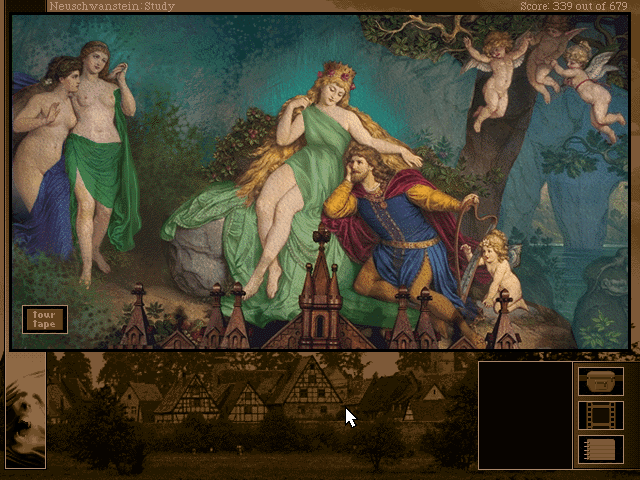
Much of Grace’s time is spent touring Neuschwanstein Castle, complete with the obligatory tourist audio guide.
Clearly Jane Jensen was touched by the wistful, sorrowful life of Ludwig, enough so as to make it the thematic bedrock of her game. She saw parallels with a certain modern eccentric whose days would also end in tragedy and controversy:
He was a real misfit, never in sync with the world. He lived in a fantasy world, and because he had a lot of money, he could surround himself with fantasy, not unlike Michael Jackson now.
As time went on, he got more and more beaten down by the world. His relationships never worked out, and he was always disillusioned. He was a very sensitive soul who was just hurt by everything, who kept retreating and withdrawing.
When he was young, he was very much a Prince Charming type. And of course his end was very tragic. So I just think it is a very beautiful, sad story of a life.
Grace’s historical research and Gabriel’s more active investigations meet only in the sixth and final chapter of the game, when the former arranges a public premiere of the lost opera in order to cure the latter of the affliction he’s picked up. The audacity of this bit is almost unbelievable. Not only did the game’s soundtrack composer Robert Holmes — also Jane Jensen’s husband — dare to write an opera, he had the colossal cheek to make it a lost Wagner opera. It took him “about a week,” as he remembers it. (One has to assume that the real Wagner devoted somewhat more time to his masterworks). I’m in no way qualified to judge the worthiness of Holmes’s opera, but I must assume it to be dire enough to send aficionados running from the room with their hands over their ears. Nevertheless, here’s to ambition. One certainly can’t accuse this game of pulling any of its punches.
All of its interest in place and history can rather overshadow its bona fides as a work of horror. Much of the time, it’s more eerie than terrifying, more melancholy than thrilling; suffice to say that it lives in a place far removed from the schlocky sensationalism of Roberta Williams’s Phantasmagoria. When the time finally does come to confront werewolves nose to snout, however, The Beast Within doesn’t disappoint. There’s one scene in the penultimate chapter — anyone who’s played the game will know which one I’m talking about — that’s unsettling enough to give you nightmares. While it’s easy enough to laugh off Phantasmagoria‘s cartoonish execution scenes, you won’t be laughing at this one. If the climax in the opera house is ironically less horrifying than what comes immediately before it, fair enough; one scene like that should be enough for any game.
All of which is to say that The Beast Within is a richly textured, admirably complex work of fiction in many ways. At its best and judged in the context of its time, it was one of the most impressive interactive narratives yet attempted on a computer by 1995. But alas, it isn’t always this best version of itself. What with so much love having been so clearly poured into the game from so many different quarters, I can’t help but wonder why Jane Jensen couldn’t manage to make it just a little bit better. Mixed in with all of its rarefied intellectual and thematic aspirations is plenty of B-movie amateurishness. The language barrier gets erected and torn down willy-nilly, depending on whether Jensen wants to make a plot element out of it or not at any given instant; particularly amusing is the Schattenjäger library in Gabriel’s family castle, consisting of a bunch of Medieval texts helpfully written in modern English. There’s no reason that plausible ways around the language problems couldn’t have been built into the game’s puzzle structure, doing much for its sense of mimesis and potentially even for its character-building in the process. (Perhaps Grace needs to enlist the help of the hated Gerde to translate?) Similarly, the game’s timeline makes no sense whatsoever. Gabriel and Grace’s separate investigations overlap with one another in ways that would only be possible if one or both had a time machine to hand.
These may strike some as the pettiest of niggles, but the fact is that continuity matters in the crafting of believable fictions of any stripe. No credible book-publishing house or film studio would allow a story to go out in such a state as this one. Plot may stand at a lower rung on the artistic totem pole than character or theme in the minds of many, but even most of these will acknowledge that a coherent plot is a necessary prerequisite to those other things.
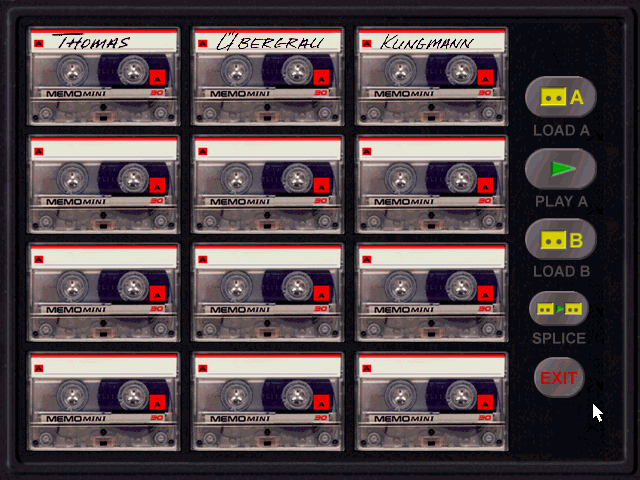
The Beast Within has some really good puzzles that stretch the interface beyond the typical “use item X on hotspot Y.” One, for example, requires you to construct a fake telephone message by splicing together snippets of recorded speech.
And then there is the interactive design. Jane Jensen resisted any pressure that may have come her way to dumb down The Beast Within in the manner of Phantasmagoria: her game is full of real puzzles worthy of the name, in some cases pretty good ones. In fact, it fares considerably better on this metric than Sins of the Fathers. Nevertheless, there remains a smattering of bad design choices that serve to pull you out of the game every time you feel yourself on the verge of becoming truly immersed in its world. A few of the puzzles hinge on the sort of moon logic for which adventure games have been so often justifiably criticized. (Using a cuckoo clock on a potted plant? Really, Jane?) Even one example of this sort of thing can be ruinous to the player’s experience, in that it destroys her trust in the game’s interactive design at the same time that it demolishes the integrity of its fiction.
In Grace’s chapters, Jensen lays claim to the dubious status of being the inventor of the hidden-object genre: you have to pixel-hunt your way through several big areas, looking for that one tiny thing you overlooked the last dozen times through. You see, this game really, really wants you to know everything possible about Richard Wagner and King Ludwig II: it won’t let the plot proceed until you’ve clicked on every last hotspot on every last detail in every last musty little corner of their respective museum and castle — in a few cases twice. Finding it all can be a challenge even if you’re playing directly from a walkthrough.
And when we get to the big finale, Jensen falls into the common trap of assuming that the ending of an adventure game ought to be much harder than what has come before. (In reality, the opposite is true; the player has already done lots of thinking during the mushy middle, and now just wants an exciting climax followed by victory, with a minimum of fuss.) One key puzzle here hinges on manipulating an object in a way that the interface has never allowed before and never even hinted was a possibility. And the literal last action you need to do in the game is a tricky exercise in perfect timing and precise clicking that’s also out of keeping with everything that’s come before, so much so that you could easily assume you’ve missed something and waste hours looking for it.
But regular readers have heard similar litanies of design sins from me many times before, so I won’t belabor these issues further here. The Beast Within is yet another checkered product of Sierra’s creative culture, which, in marked contrast to such other adventure specialists as Infocom, LucasArts, and Legend Entertainment, never emphasized outside play-testing or even serious discussion of the craft of design in the abstract. Interesting and engaging as it is in its present state, it could have been so much better, if only a process had been put in place to make it better. Whatever the merits of his year-to-year choices as a businessman, Ken Williams’s failure to do so — a byproduct of his personal disinterest in actually playing his company’s games — will always stand as his biggest single lapse in my book.
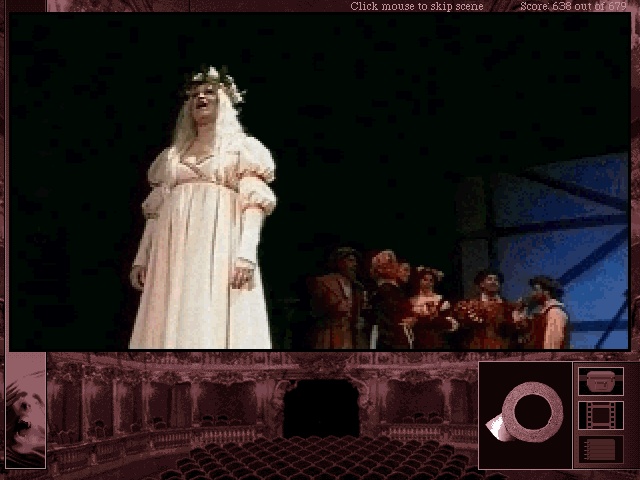
Wagner’s Lost Opera, the grand finale to The Beast Within. Most games, then and since, have tended to front-load their most impressive scenes so that everyone — not least potential buyers — can see them. This one’s willingness to hold off until the very end says something, I think, about the spirit of grandiose (operatic?) idealism that marked the whole project.
The Beast Within: A Gabriel Knight Mystery shipped on six CDs less than a week before the Christmas of 1995, half a year after Phantasmagoria had been greeted with huge sales and much mainstream-press attention. Everything about this latest release reflected the current ebullient mood at Sierra, where everyone was convinced they were about to truly hit the big time, with a vastly expanded customer base. For example, the box was careful not to say that this was “Gabriel Knight 2,” for fear of scaring away that new generation of buyers, who might not be keen on starting a series in the middle and might be even less keen on playing an “old-fashioned” game like Sins of the Fathers.
Indeed, even Sierra’s new fictional genre of choice reflected the new focus on the mainstream. Horror was a less stereotypically nerdy ghetto than fantasy or science fiction, yet one that was still fairly well-suited to adventure-game modes of interaction. So, after never touching the genre for the first decade and change of their existence, Sierra was now all over it. Three of the five domestically-developed adventures they released in 1995 were horror games. (The third companion to Phantasmagoria and The Beast Within in this respect was the lower-profile Shivers, a solitary Myst-style first-person puzzler created by a breakaway team at Bright Star, Sierra’s educational-software subsidiary.)
In comparison to the adventure-lite Phantasmagoria, The Beast Within was perhaps a wolf in sheep’s clothing: it was, as we’ve seen, a game that evinced a full measure of respect for its audience’s collective intelligence, with challenging puzzles and complex present-day and historical mysteries to tease out. Still, there’s little reason to believe it was because of this that it failed to sell anywhere near as well as its predecessor. The mainstream magazines and newspapers that had covered the older game as a curiosity showed little interest in the newer one; ditto the many people who had bought Phantasmagoria strictly to show off their new multimedia computer systems. That left only the traditional adventure market, the same people who had bought Sins of the Fathers. It seemed that Sierra was suddenly back to square one.
This state of affairs was, to say the least, deeply disconcerting to everyone there, as they all found themselves having to adjust their paradigm of gaming’s necessary future at lightning speed. Sierra programmer Greg Tomko-Pavia expressed the collective confusion in a contemporary online interview whose frankness presumably wouldn’t have endeared it to his managers:
I must say that I’m surprised Phantasmagoria has done so well. Presently, we’ve sold over 700,000 copies — more than any other Sierra game. I can’t account for it. In my opinion, Phantasmagoria suffered from weak writing, acting, and direction. I don’t understand why Gabriel Knight 2, to my mind superior in every detail, isn’t doing nearly so well. What do I know? I just write code!
At the time of The Beast Within‘s release, Sierra was already filming their third big interactive horror film on their Oakhurst sound stage, a sequel-in-name-only to Phantasmagoria subtitled A Puzzle of Flesh. Its garish grindhouse aesthetic made its two boundary-pushing predecessors look downright prudish — which was, one supposes, further progress of a sort. But it would prove the last production of its type. Once it too had disappointed in the marketplace, its feverish courting of controversy having largely come up dry, the facility Sierra had built with such pride and at such expense would be used only occasionally, for 3D motion captures and the like. It was now clear that gaming writ large was going in a different direction entirely, leaving the sound stage a fork in a world of soup.
As for Gabriel and Grace: against all the odds, they would return for one final game, but that would be a more constrained production than this one, using one of the 3D engines that were taking over the industry. There’s a world-weariness about that game — a sense of existential despair on the part of its creators that’s almost palpable when playing it — that you won’t find in this one, which was created by a team who saw only limitless potential everywhere they looked. The Beast Within is the product of a rare moment when the creative and the commercial impulse seemed united as one. For all its frustrating infelicities, it positively soars with its makers’ enthusiasm, with their bracing willingness to just try. Neither Jane Jensen nor any of the rest of them realized how lucky they were to be given the time and money to do so.
Six months after the release of The Beast Within, Roberta Williams, who was always the bellwether of the current creative direction of Sierra, gave a new verdict on the current state of adventure games that contradicted everything Sierra had been saying and doing for the past couple of years:
I believe adventure games have now gotten too plot-heavy. Not just ours, but also a lot of our competitors’ games. I think game designers need to get back to the game and forget all this wanna-be-writer-and-director stuff. They don’t realize people just want to play a game. They want to have control over what happens. Video clips are fine — if they’re very short, to the point, concise, and then… get out of there.
The times, they were still a-changing.
(Sources: the books Influential Game Designers: Jane Jensen by Anastasia Salter and The Beast Within: Official Player’s Guide by Corey Sandler with Jane Jensen; Computer Gaming World of November 1995 and February 1996; Sierra’s customer newsletter InterAction of Fall 1994, Spring 1995, Fall 1995, Holiday 1995, Spring 1996, and Summer 1996. Online sources include Anthony Larme’s interview with Greg Tomko-Pavia, “The Making of… the Gabriel Knight Trilogy” at Edge Online, Andrea Santorio’s interview with Jane Jensen, Martin Bourassa’s interview with Dean Erickson, Jane Jensen and Robert Holmes’s appearance on a Reddit “Ask Me Anything,” and Ingrid Heyn’s interview with Will Binder.
Now re-titled with the numeral Sierra once eschewed, Gabriel Knight 2: The Beast Within is available as a digital purchase at GOG.com.)
Footnotes
| ↑1 | This résumé would later lead to my favorite ever interview opening, from the adorably fannish website Adventure Classic Gaming: “You have worked with some of the best actors in the business — Al Pacino, Michael J. Fox, Bruce Boxleitner, Mira Furlan, Philip Seymour Hoffman, and of course, Dean Erickson and Joanne Takahashi.” Two of these names are not like the others… |
|---|

